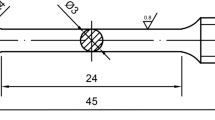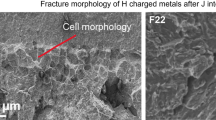Abstract.
The effect of hydrogen on the fatigue properties of alloys which are used in fuel cell (FC) systems has been investigated. In a typical FC system, various alloys are used in hydrogen environments and are subjected to cyclic loading due to pressurization, mechanical vibrations, etc. The materials investigated were three austenitic stainless steels (SUS304, SUS316 and SUS316L), one ferritic stainless steel (SUS405), one martensitic stainless steel (0.7C-13Cr), a Cr-Mo martensitic steel (SCM435) and two annealed medium-carbon steels (0.47 and 0.45%C). In order to simulate the pick-up of hydrogen in service, the specimens were charged with hydrogen. The fatigue crack growth behaviour of charged specimens of SUS304, SUS316, SUS316L and SUS405 was compared with that of specimens which had not been hydrogen-charged. The comparison showed that there was a degradation in fatigue crack growth resistance due to hydrogen in the case of SUS304 and SUS316 austenitic stainless steels. However, SUS316L and SUS405 showed little degradation due to hydrogen. A marked increase in the amount of martensitic transformation occurred in the hydrogen-charged SUS304 specimens compared to specimens without hydrogen charge. In case of SUS316L, little martensitic transformation occurred in either specimens with and without hydrogen charge. The results of S-N testing showed that in the case of the 0.7C–13Cr stainless steel and the Cr–Mo steel a marked decrease in fatigue resistance due to hydrogen occurred. In the case of the medium carbon steels hydrogen did not cause a reduction in fatigue behaviour. Examination of the slip band characteristics of a number of the alloys showed that slip was more localized in the case of hydrogen-charged specimens. Thus, it is presumed that a synergetic effect of hydrogen and martensitic structure enhances degradation of fatigue crack resistance.
Similar content being viewed by others
References
J.J. Au H.K. Birnbaum (1973) ArticleTitleMagnetic relaxation studies of hydrogen in iron: relaxation spectra Scripta Metallurgica 7 595–604 Occurrence Handle10.1016/0036-9748(73)90221-4
R.B. Benson SuffixJr R.K. Dann L.W. Robert SuffixJr (1968) ArticleTitleHydrogen embrittlement of stainless steel Transformation of the Metallurgical Society of AIME 242 2199–2205
Birnbaum, H.K., Robertson, I.M. and Sofronis, P. (2000). Hydrogen effects on plasticity. In: Multiscale Phenomena in Plasticity, (edited by Lepinoux, J.), Kluwer Academic Publishers, Dordrecht.
H.K. Birnbaum P. Sofronis (1994) ArticleTitleHydrogen-enhanced localized plasticity-a mechanism for hydrogen-related fracture Material Science and Engineering A176 191–202 Occurrence Handle10.1016/0921-5093(94)90975-X
A.M. Brass J. Chene (1998) ArticleTitleInfluence of deformation on the hydrogen behavior in iron and nickel base alloys: a review of experimental data Material Science and Engineering A242 210–221 Occurrence Handle10.1016/S0921-5093(97)00523-6
J.A. Clum (1975) ArticleTitleThe role of hydrogen in dislocation generation in iron alloys Scripta Metallurgica 9 51–58 Occurrence Handle10.1016/0036-9748(75)90145-3
J.F. Dufresne A. Seeger (1976) ArticleTitleHydrogen relaxation in α-iron. Groh P. and Moser P. Physics Statistics Solutions (a) 36 579–589
Farrell K. and Quarrell A.G. (1964). Hydrogen embrittlement of an ultra-high-tensile steel. Journal of the Iron and Steel Institute December, 1002–1011.
H.C. Fiedler B.L. Averbach M. Cohen (1954) ArticleTitleThe effect of deformation on the martensitic transformation in austenitic stainless steels Transaction of the ASME 47 267–290
W.R. Heller (1961) ArticleTitleQuantum effects in diffusion: internal friction due to hydrogen and deuterium dissolved in α iron Acta Metallurgica 9 600–613 Occurrence Handle10.1016/0001-6160(61)90165-1
E. Herms J.M. Olive M. Puiggali (1999) ArticleTitleHydrogen embrittlement of 316L type stainless steel Materials Science and Engineering A 272 279–283 Occurrence Handle10.1016/S0921-5093(99)00319-6
J.P. Hirth (1980) ArticleTitleEffect of hydrogen on the properties of iron and steel Metallurgical Transactions A 11A 861–890 Occurrence Handle1980MTA....11..861H
Kanezaki, T., Mine, Y., Fukushima, Y. and Murakami, Y. (2004). Effects of hydrogen on fatigue crack growth behaviour and ductility loss of austenitic stainless steels. Proc. of ECF15, CD-ROM.
H. Kimura H. Matsui (1979) ArticleTitleReply to “further discussion on the lattice hardening due to dissolved hydrogen in iron and steel” by Asano and Otsuka Scripta Metallurgica 13 221–223 Occurrence Handle10.1016/0036-9748(79)90298-9
T. Magnin C. Bosch K. Wolski D. Delafosse (2001) ArticleTitleCyclic plastic deformation behaviour of Ni single crystals oriented for single slip as a function of hydrogen content Material Science and Engineering A314 7–11 Occurrence Handle10.1016/S0921-5093(00)01920-1
H. Matsui H. Kimura (1979) ArticleTitleThe effect of hydrogen on the mechanical properties of high purity iron III. The dependence of softening on specimen size and charging current density Material Science and Engineering 40 227–234 Occurrence Handle10.1016/0025-5416(79)90193-9
F. Mignot V. Doquet C. Sarrazin-Baudoux (2004) ArticleTitleContribution of internal hydrogen and room-temperature creep to the abnormal fatigue cracking of Ti6246 at high K max Material Science Engineering A380 308–319 Occurrence Handle10.1016/j.msea.2004.04.006
Y. Murakami (2002) Metal Fatigue: Effect of Small Defects and Nonmetallic Inclusions Elsevier Oxford
Murakami, Y. (2004). Keynote lecture, The Kick-off Conference for the Fukuoka Hydrogen Energy Project Alliance, August, 3.
Y. Murakami M. Endo (1986a) ArticleTitleEffects of hardness and crack geometry on ΔK th of small cracks Journal of the Society of Material Science Japan 35 911–917
Murakami, Y. and Endo, M. (1986b). Effects of hardness and crack geometries on ΔK th of small cracks emanating from small defects. In: The Behaviour of Short Fatigue Cracks, EGF Pub.1, (edited by Miller, K.J. and delos Rios), Mechanical Engineering Publications, London, 275–293.
Y. (Yukitaka) Murakami H. Konishi K. Takai Y. (Yasuo) Murakami (2000) ArticleTitleAcceleration of superlong fatigue failure by hydrogen trapped by inclusions and elimination of conventional fatigue limit. Tetsu-to-Hagane 86 777–783
Y. Murakami C. Makabe H. Nisitani (1989) ArticleTitleEffects of small surface cracks on ductility loss in low cycle fatigue of 70 / 30 brass Journal of Testing and Evaluation. JTEVA 17 20–27 Occurrence Handle10.1520/JTE11529J
Y. Murakami K.J. Miller (2005) ArticleTitleWhat is fatigue damage? A viewpoint from the observation of low cycle fatigue process International Journal of Fatigue 27 991–1005 Occurrence Handle10.1016/j.ijfatigue.2004.10.009 Occurrence Handle1068.74501
Y. Murakami J. Nagata (2005) ArticleTitleEffect of hydrogen on high cycle fatigue failure of high strength steel, SCM435 Journal of the Society of Material Science Japan 54 420–427 Occurrence Handle10.2472/jsms.54.420
Y. Murakami T. Nomoto T. Ueda (1999) ArticleTitleFactors influencing the mechanism of superlong fatigue failure in steels Fatigue Fracture Engineering Material Structures 22 581–590 Occurrence Handle10.1046/j.1460-2695.1999.00187.x
Murakami, Y. (Yukitaka), Ueda, T., Nomoto, T., Murakami, Y. (Yasuo) (1998). Analysis of the mechanism of superlong fatigue failure by optical microscope and SEM/AFM observations. Proceedings of the 24th Symposium on Fatigue, 47–50.
Murakami Y. (Yukitaka), Ueda T., Nomoto T., Murakami Y. (Yasuo) (2000). Mechanism of superlong fatigue failure in the regime of N > 107 cycles and fractography of the fracture surface. Transactions of the Japan Society of Mechanical Engineers A66:311–319.
Murakami Y., Yokoyama N.N. and Takai K. (2001). Effect of hydrogen trapped by inclusions on ultra-long life fatigue failure of bearing steel. Journal of the Society of Material Science Japan 50, 1068–1073.
J. Nagata Y. Murakami (2003) ArticleTitleFactors influencing the formation of ODA in ultralong fatigue regime Journal of the Society of Material Science Japan 52 966–973
Y. Sakamoto H. Katayama (1982) ArticleTitleThe electrochemical determination of diffusivity and solubility of hydrogen in an austenitic type 304 steel Journal of the Japan Institute Metals 46 805–814
O.N. Senkov J.J. Jonas (1996) ArticleTitleDynamic strain aging and hydrogen-induced softening in alpha titanium Metallurgica and Materials Transactions A 27A 1877–1887 Occurrence Handle1996MMTA...27.1877S
D.S. Shih I.M. Robertson H.K. Birnbaum (1988) ArticleTitleHydrogen embrittlement of α titanium: in situ TEM studies Acta Metallurgica 36 111–124 Occurrence Handle10.1016/0001-6160(88)90032-6
T. Shiina T. Nakamura T. Noguchi (2004) ArticleTitleEffect of stress ratio on surface- and interior-originating fatigue properties of high strength steel Transactions of the Japan Society of Mechanical Engineers A70 1042–1049
K. Takai Y. Homma K. Izutsu M. Nagumo (1996) ArticleTitleIdentification of trapping sites in high-strength steels by secondary ion mass spectrometry for thermally desorbed hydrogen Journal of the Japan Institute Metals 60 1155–1162
Uyama, H., Mine, Y. and Murakami, Y. (2004). Effects of hydrogen charge on cyclic stress-strain properties and fatigue behaviour. Proceedings of ECF15 (2004) CD-ROM.
Author information
Authors and Affiliations
Corresponding author
Rights and permissions
About this article
Cite this article
Murakami, Y. The Effect of Hydrogen on Fatigue Properties of Metals used for Fuel Cell System. Int J Fract 138, 167–195 (2006). https://doi.org/10.1007/s10704-006-7158-2
Received:
Accepted:
Issue Date:
DOI: https://doi.org/10.1007/s10704-006-7158-2




